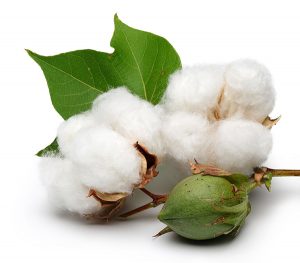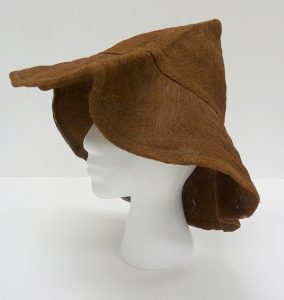FLORA AND FASHION: SEED FIBERS: COTTON, COIR, KAPOK, MILKWEED

September 20, 2018
Seed fibers develop in the seedpod of the plant from which it must be separated to be used. Seed fibers include cotton, coir, kapok, and milkweed. COTTON is a seed fiber that grows within a pod or boll from developing seeds and is the most common natural fiber used in the apparel industry. Cotton cloth has been used for millennia by people of ancient Egypt, China, India, Mexico, and Peru. Cotton fiber makes a soft and breathable fabric that is absorbent and comfortable. It is also easily blended with other fibers. Today, cotton denim is one of the most popular fabrics in the world. It is also one of the most environmentally damaging of all fibers utilized in the apparel industry. Cotton is a water-intensive crop that requires at least 20 inches of rain per year, acquired through natural rainfall and/or irrigation. One cotton shirt requires 2,700 liters of water (what one person drinks in 2.5 years.)(1) Fabric dyeing also uses 1.3 trillion gallons of water each year.(2)
Cotton is used to make a wide variety of fabrics from terrycloth to shirts to socks and t-shirts. The cotton fiber varies in length from under ½ inch up to 2 ½ inches, the length being a determining factor in quality. The two best known long staple cottons are Egyptian and Pima. A variety of finishing processes are used on cotton fabrics to make it more wrinkle resistant or to control shrinkage. Cotton denim finishes include acid and stone washing, laser detailing, dry ice blasting, and distressing. Cotton is also a major component of many blended fibers. As a result, cotton is an important cash crop in more than 80 countries, including China, the United States, India, Pakistan, Turkey, and Brazil.(2) However, despite cotton’s status as the most widely used seed fiber, it is also the most environmentally damaging of the natural fibers. Farming methods often make extensive use of chemicals for fertilization, pest and insect control, and plant growth. Cotton farming is responsible for 24% of insecticides and 11% of pesticides despite using about 3% of the world’s arable land.(2)
















COIR is a fibrous material from the tissues surrounding the seed of the coconut palm (Cocus nucifera.) The processing of coir fiber uses only about 25%-30% of the total coconut husk (10); the remaining waste is often used for mulch and fertilizer.(24) Coir is an abundant, renewable natural resource and textiles made from coir are considered very durable and 100% biodegradable.(24) India and Sri Lanka are the main exporters of coir, followed by Thailand, Indonesia, Malaysia, Vietnam, and the Philippines.(24) Traditional uses include floor coverings, carpets, door mats, mattress filling, ropes, and twine.
KAPOK comes from the seed of the Ceiba or “Silk Cotton” tree (Ceiba pentandra.) Kapok tree “fruit hairs” are packed inside a large pod which splits open when ripe. The fine, silky lustrous fibers are thermally insulating, water repellent and buoyant. These latter characteristics made kapok ideal for use in life preservers, vests and buoys. Milkweed was used as a substitute for kapok during World War II when Japan cut off the U.S. supply (28) and synthetic substitutes were developed.(26) Today, kapok fibers are used as fillers in life jackets and life belts, as stuffing for upholstery and bedding, and for acoustic and thermal insulation.(27) MILKWEED (Asciepius syriaca) is a weak, smooth fiber resembling kapok, and is obtained from large seedpods. The silky, lightweight fibers are rarely used to make clothing.(29)

SOURCES
(1) Chhabra, Esha. The Dirty Secret About Your Clothes. December 30, 2016. https://www.washingtonpost.com/business/the-dirty-secret-about-your-clothes/2016/12/30/715ed0e6-bb20-11e6-94ac-3d324840106c_story.html?noredirect=on&utm_term=.3f80c90bf39c
(2) Kadolph, Sara J. Textiles, 10th Edition. New Jersey: Pearson Education Inc. 2007.
(3) https://www.levistrauss.com/how-we-do-business/source/. Retrieved 7.16.2019
(10) Coir. International Natural Fiber Organization. http://naturalfibersinfo.org/?page_id=84. Retrieved August 7, 2019.
(23) Blok, Crhis, Cees De Kreij, Rob Baas, Gerrit Wever. “Analytical Methods Used in Soilless Cultivation. Soilless Culture: Theory and Practice. 2008, pages 245-289. https://www.sciencedirect.com/science/article/pii/B9780444529756500095?via%3Dihub. Retrieved August 13, 2019.
(24) Future Fibres. Food and Agriculture Organization of the United Nations. http://www.fao.org/economic/futurefibres/fibres/coir/en/. Retrieved August 13, 2019.
(26) What is Kapok. Ceiba Foundation for Tropical Conservation. https://ceiba.org/wp-content/uploads/The_Ceiba_Tree.pdf Retrieved August 13, 2019.
(27) Kapok. Transport Information Service. http://www.tis-gdv.de/tis_e/ware/fasern/kapok/kapok.htm. Retrieved August 13, 2019.
(28) Woodward, Mylinda. “Pod Squad.” UNH Magazine. University of New Hampshire, Fall 2013.
(29) Milkweed Fiber. Conservation and Art Materials Encyclopedia Online, Museum of Fine Arts Boston. http://cameo.mfa.org/wiki/Milkweed_fiber. Retrieved August 13, 2019.
(33) Charlton, Emma. Your Coat Could Be About To Get Its Own Passport. World Economic Forum. July 26, 2019. https://www.weforum.org/agenda/2019/07/your-coat-could-be-about-to-get-its-own-passport/?fbclid=IwAR022x7f-QQi9rRzn6CGcNO2q8bmP0T7HhVG4vB0N5P9E8KWmBEB5ONZP7k. Retrieved August 30, 2019.